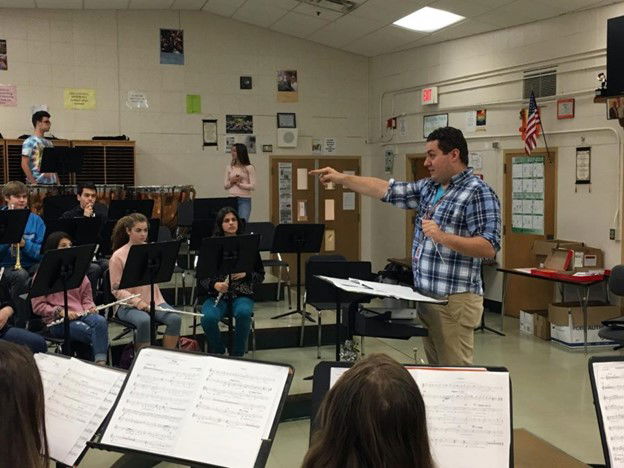How to Choose the Best Music for a Concert Band

Selecting music for a concert band is an art that requires careful consideration and a keen understanding of both the band's capabilities and the musical nuances embedded within a piece. A band director plays a pivotal role in this process, serving as a guiding force in selecting music that not only challenges the ensemble but also ensures a fulfilling musical experience. Here's an in-depth guide on how a concert band director can assess and determine if a band piece is suitable for their band.
UNDERSTANDING THE BAND'S PROFICIENCY
Before delving into the selection process, it's crucial for a band director to comprehend the band's proficiency level. Assessing the instrumental skills, tonal quality, technical abilities, and overall musical comprehension of the band is fundamental. This knowledge forms the cornerstone for selecting appropriate music that aligns with the band's current capabilities while gently pushing them to new heights.
- Assessment of Technical Skills: Evaluate the instrumental expertise of the band members. Consider factors like range, dexterity, articulation, and intonation. A piece that aligns with the band's technical abilities ensures a smooth learning process. Those musicians that play first parts, (first trumpet, clarinet, etc.) will, of course, be able to play a wider range, have better breath control and dexterity and other higher level skills than the second or third part players. It may be necessary to evaluate the players with the lesser skills to be sure that the music being considered doesn’t exceed these levels.
- Tonal Quality and Ensemble Balance: Understanding the ensemble's balance and tonal quality is essential. Assess the strengths and weaknesses of various sections and individual players to ensure the selected piece does not overwhelm or under-utilize any specific section. It seems that each year, the composition of a band changes. A conductor may find that a fair number of excellent players have moved on (graduated or found other interest, etc.). They are then left with less experienced players.
- Musical Complexity and Challenges: Analyze the band's comfort with various musical complexities such as rhythmic intricacies, key changes, time signatures, and dynamic contrasts. Gradually introducing challenges without overwhelming the band is vital for growth. This gradual introduction is known as the Pygmalion Effect and is very effective in improving a concert band’s performance and skill levels.
There are a number of ways by which a band director can assess a player’s technical skills, tonal quality, and ability to meet the challenges of complex music. Here are a couple ways that have also been used in choosing section leaders. The basic process is the same. These assessments encompass technical proficiency, sight-reading abilities, and prepared repertoire to fairly evaluate each players skills. This approach ensures an impartial and transparent process in evaluating . For a truly objective evaluation, these should be conducted blindly. Here are the methods:

Obvious Evaluation – The first one is conducted in a way similar to the way a professional music ensemble would choose its players and leaders. This would work in larger bands. It would also have to be performed in such a way as to foster healthy competition and recognition of accomplishment rather than encouraging the wrong kind of pride and reinforcing a shame culture.
- Each musician chooses a number, randomly drawn.
- Each one performs a prescribed set of pieces behind a screen so that the director can hear, but not see the candidate. The set of pieces should include a prepared piece chosen by the director, this one being the same for all players. It would include all of the technical skills that are being evaluated.
- Each musician would also perform a piece not seen before to test sight reading skills.
The conductor would have to set a range of performance criteria from which the evaluation can be constructed. The criteria range would have to be somewhat general because some of the criteria would be somewhat subjective. For example, what defines “good tone” from an instrument? And, what determines the ideal upper range for a particular instrument?
Covert Evaluation – The second one may prove a little more difficult but, in the end it may be better, especially in a smaller or less mature band, to evaluate the players while lessening the danger of hurting the feelings of, or undermining the confidence of the musicians. In this one, the director is using a more covert method.
- During a regular rehearsal, the director asks to hear each section play a section of a well-rehearsed tune. The director can say that he or she is investigating something, which is the truth, and not to be bothered as he or she wanders around among them.
- While each section plays, the director does what was described and wanders among the players, listening, critiquing and making note, mentally or on paper.
- The same process can then be used with a piece that the band has never played before, perhaps one that the director is considering using. That way, the director can analyze the players’ sight reading skills and see if the piece is one that they might like to play.

EVALUATING THE PIECE Once armed with an understanding of the band's capabilities, the band director can meticulously examine a potential piece to ascertain its suitability. Several criteria can be considered:
- Scoring and Instrumentation: Review the instrumentation required for the piece. Ensure it aligns with the available instruments within the band. Verify that the piece provides opportunities for all sections to contribute meaningfully to the performance. Not every piece will meet the needs of a particular band.
- Level of Difficulty: Carefully assess the technical demands of the piece. Evaluate the range, speed, and complexity of rhythms. Compare these elements with the band's skill level to determine if the piece poses a suitable challenge without being overly daunting. Remember that the lower parts need to be considered as much or more than the top parts.
There are a number of rating scales that different composers and publishers use to try to communicate how easy or difficult a piece is. These are very general guidelines. Every band is different and the composition of the band changes each year, so it’s up to the band director to make his or her best guess. If the piece chosen happens to be a bit too easy for the band. Perhaps they could work on extracting extra tone or dynamic differences from the piece. If the new piece is a bit too difficult, without being impossible, it will work as an accomplishable challenge, raising the band’s skill level and providing a true sense of accomplishment.
Salt Cellar Creations has a growing catalog of music for concert bands of different sizes and skill levels. Beyond that, we are eager, willing and able to adjust any of its music to fit a particular band’s needs. Once you peruse the offerings for BAND, you can decide if any changes need to be made and can CONTACT US for information about changes.
- Musical Style and Theme: Consider the musical style and thematic elements of the piece. Ensure it aligns with the band's musical interests and abilities to evoke a sincere and passionate performance.
A good band director will provide a wide variety of music styles and themes for the band to play. There will, however, be some pieces that won’t appeal to the band as a whole. For instance, a somber tone poem may be a difficult piece to convince a group of high school age students to play. - Teaching Opportunities: Look for pieces that offer teaching moments. A piece that introduces new techniques or musical concepts can be valuable in the band's educational journey. Salt Cellar Creations has a number of pieces that fit well into this category. With music from SCC, a conductor can introduce concepts like musical form, especially with Rockin’ Rondo, which is a full classical rondo. Time signature changes and relative major and minor keys are explored in Baroquen Carriage. For trumpets, there are some alternate fingerings required to play parts of the arrangement of Bridge Over Troubled Water. And Minuet in Four is a great introduction to Bach.
- Audience Appeal: Consider the potential audience's preferences and the context in which the piece will be performed. A piece that resonates with the audience while showcasing the band's strengths can be highly rewarding.

THE DECISION-MAKING PROCESS
After a thorough evaluation, the band director should weigh the gathered information against the band's proficiency level and objectives. It's essential to strike a balance between comfort and challenge, fostering growth and maintaining enthusiasm within the band.
- Listen and Play-through: Listen to recordings and, if possible, obtain a score to play through the piece. This practical experience can provide invaluable insights into the challenges and overall feel of the music. The recording offered by SCC are computer renderings of the score so that the conductor and the band can hear what it’s supposed to sound like. Be sure to let the band hear the music being considered as well. They may not have the final say, but it’s always good to have their input.
As you listen to the recordings of the music by Salt Cellar, be sure to point out the opportunities to shine that our music offers. Many of our pieces allow for instruments that normally provide only support parts (e.g., French horn, bassoon) to play melodies and other interesting parts. - Consultation and Rehearsal Consideration: Discuss the potential piece with fellow music educators, seek their opinions, and consider how the piece fits into the band's rehearsal schedule and overall educational objectives.
Some other bands may have played the piece that the director is considering and found it to be a big hit with players and audiences. Other music may not have lived up to the expectations of director, band or audience.
Some bands have the privilege of meeting five days a week. These ensembles can afford to tackle more difficult music. Others may be restricted to two or three days a week; they would need to settle for something a little less challenging.
Some high schools employ a comprehensive curriculum in which they choose a theme or set of themes for the year. One method involves choosing a period in history, and all of the other subjects are taught from that vantage point. For example, if the chosen period was the Renaissance, the books in English class would be from that period, the math concepts would be the ones that were either discovered or used most frequently in the period, the science class would study the scientific method if the day and what discoveries were made, and the music for choral and instrumental groups would be from that time period. This may be the only educational objective that would need to be met outside of improving music skills.
- Flexibility and Adaptability: While selecting a piece, maintain a degree of flexibility. Consider modifications or adaptations that could make a challenging piece more accessible or vice versa. Salt Cellar Creations can make changes if you CONTACT US for information. Remember that copyrighted music cannot be changed without the composer or arranger’s permission.
- Long-Term Planning: Align the selected piece with a long-term vision for the band's growth. Consider the trajectory of development and how the selected music contributes to this evolution. It may have to go into a rotation to account for waves of talent that seem to come and go in a band, especially in a school setting.
CONCLUSION Selecting suitable music for a concert band demands a delicate balance between challenge and comfort, tailored to the band's abilities and objectives. A band director's ability to assess the band's proficiency level and effectively evaluate potential pieces is instrumental in nurturing the band's growth and delivering exceptional musical performances.
By considering the technical aspects, musical complexity, audience appeal, and teaching opportunities, a band director can confidently choose pieces that inspire, challenge, and showcase the band's talents, ensuring a fulfilling musical journey for both the performers and their audience.
Salt Cellar Creations understands the diversity of beauty and power that a Concert Band can convey to its listeners and has a growing library of original works and arrangements. Find out more about what Salt Cellar Creations has to offer for Concert Bands HERE. Explore the available music HERE.
SCC can also compose an original piece for you or do a custom arrangement for you. There are two ways that this can be done; one is much more affordable than the other. And SCC is always looking for ideas of pieces to arrange or suggestions for original pieces.
We have sold music not only in the US but in Canada, the United Kingdom, France, Australia, New Zealand and Austria. Please visit the WEBSITE or CONTACT US to let us know what we can do for you!